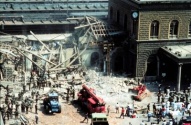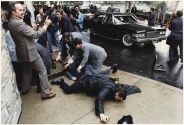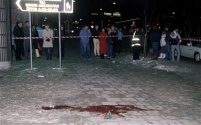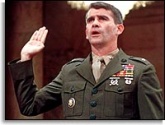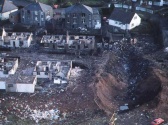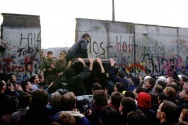1980s
| 1970s« | |
|---|---|
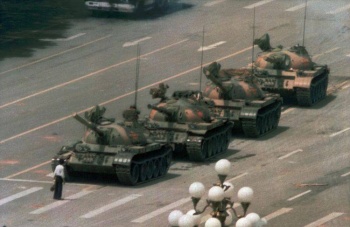 The still unidentified 'Tank Man' facing down a column of tanks Tiananmen Square on June 5, 1989 | |
| The 1980s saw an increase in the global organisation of capital, and a dramatic end to the coherence of the Soviet empire. |
The 1980s saw the effective end of the Cold War and associated nuclear arms race. However, arms expenditures actually increased, as the MICC hyped the threat of international "terrorism".
Contents
Exposure of Operation Gladio
- Full article:
 Operation Gladio
Operation Gladio
- Full article:
Operation Gladio killed European civilians throughout the 1980s, with false flag attacks such as the 1980 Bologna massacre. This lead to the exposure of Operation Gladio in Italy.
End of the Soviet Empire
The dissolution of the USSR lead to an end to the cold war. After brief talk of a 'peace dividend', the military industrial complex was to work though the 1990s, promoting the "war on terrorism" narrative prepared at the 1979 Jerusalem COnference on International Terrorism. A 1984 conference in Washington had assisted in the global implementation of this plan.
Tianenman Square
Chinese students, inspired by the collapse of communist governments in Eastern Europe, tried to wrest control from the old communist leaders, massing in tens of thousands.
Related Quotations
| Page | Quote | Author | Date |
|---|---|---|---|
| Le Cercle | “can be seen to be an international coalition of right-wing intelligence veterans, propaganda assets and top politicians who would shape the 1970s and 1980s.” | David Teacher | 2008 |
| Manuel Noriega | “He was a pawn in an international game that was way bigger than him and he certainly paid dearly," said Barbara Trent, a filmmaker who directed "The Panama Deception," a 1992 documentary about the U.S. invasion.
"He was a small-time player catapulted to international fame by the U.S. government and the media to drum up support for a ruthless invasion," Trent added. Working with the CIA Noriega ruled Panama from 1983 to 1989. Before and during that time, he worked with multiple U.S. intelligence agencies who agreed to ignore allegations that he was a drug trafficker in exchange for a staunch anti-communist ally in Central America during the height of the Cold War. Noriega was paid handsomely for his help, about $10,000 per month at one point, according to John Dinges, author of "Our Man in Panama: How General Noriega Used the United States and Made Millions in Drugs and Arms (1990)." "The relationship with the CIA and the Pentagon was quite intense in the early '80s," Dinges told ABC News. "He was considered an important asset, and everyone in the documents I've read spoke very highly of him. He was trusted to the extent that you trust someone who is a paid intelligence asset.” | Manuel Noriega ABC News Kaelyn Forde | 2017 |
